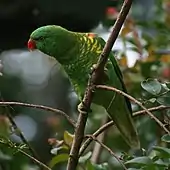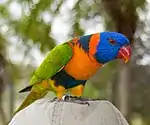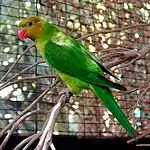| Trichoglossus | |
|---|---|
_on_fence%252C_Sydney.jpg.webp) | |
| Rainbow lorikeet (T. moluccanus) perching on a garden fence in Sydney, Australia | |
| Scientific classification | |
| Domain: | Eukaryota |
| Kingdom: | Animalia |
| Phylum: | Chordata |
| Class: | Aves |
| Order: | Psittaciformes |
| Family: | Psittaculidae |
| Tribe: | Loriini |
| Genus: | Trichoglossus Stephens, 1826 |
| Type species | |
| Psittacus haematodus coconut lorikeet Linnaeus, 1771 | |
Trichoglossus is a genus of lorikeet in the Psittaculidae or true parrot superfamily. The genus is distributed widely through Australia, Wallacea and Melanesia, with outliers in the Philippines and Micronesia. Members of the genus are characterised by barring, sometimes prominently, on the upper breast.[1]
Taxonomy
The genus Trichoglossus was introduced in 1826 by the English naturalist James Francis Stephens.[2] The name combines the Ancient Greek thrix meaning "hair" and glōssa meaning "tongue".[3] The type species was subsequently designated as the coconut lorikeet.[4][5]
Following the publication of a molecular phylogenetic study of the lorikeets in 2020, three species were moved from Trichoglossus to the newly erected genus Saudareos. These were the Mindanao lorikeet, the ornate lorikeet and the Sula lorikeet (formerly the citrine lorikeet).[6][7][8]
Species
The genus contains ten species:[8]
| Image | Common name | Scientific name | Distribution |
|---|---|---|---|
 | Pohnpei lorikeet | Trichoglossus rubiginosus | Pohnpei (Micronesia) |
 | Scaly-breasted lorikeet | Trichoglossus chlorolepidotus | Eastern Australia |
 | Coconut lorikeet | Trichoglossus haematodus | south Moluccas, west New Guinea and east to Loyalty Islands |
 | Biak Lorikeet | Trichoglossus rosenbergii | Biak Island |
 | Rainbow lorikeet | Trichoglossus moluccanus | Australia, (introduced to Hong Kong) |
 | Red-collared lorikeet | Trichoglossus rubritorquis | east Lesser Sundas to north Australia |
 | Olive-headed lorikeet | Trichoglossus euteles | Lesser Sundas: Indonesia and Timor-Leste |
 | Marigold lorikeet | Trichoglossus capistratus | Islands of Sumba, Wetar and Timor in south-east Asia |
 | Leaf lorikeet | Trichoglossus weberi | Flores |
 | Sunset lorikeet | Trichoglossus forsteni | west Lesser Sunda Islands |
References
- ↑ Low, Rosemary (1978). Lories and Lorikeets. Inkata Press: Melbourne. p. 69. ISBN 0-909605-08-4.
- ↑ Stephens, James Francis (1812). General Zoology, or Systematic Natural History. Vol. 14, Part 1. London: Kearsley et al. p. 129.
- ↑ Jobling, James A. (2010). The Helm Dictionary of Scientific Bird Names. London: Christopher Helm. p. 389. ISBN 978-1-4081-2501-4.
- ↑ Lesson, René P. (1828). Manuel d'ornithologie, ou Description des genres et des principales espèces d'oiseaux (in French). Vol. 2. Paris: Roret. p. 147.
- ↑ Dickinson, E.C.; Remsen, J.V. Jr., eds. (2013). The Howard & Moore Complete Checklist of the Birds of the World. Vol. 1: Non-passerines (4th ed.). Eastbourne, UK: Aves Press. p. 382. ISBN 978-0-9568611-0-8.
- ↑ Smith, B.T.; Mauck, W.M.I.; Benz, B.W.; Andersen, M.J. (2020). "Uneven missing data skew phylogenomic relationships within the lories and lorikeets". Genome Biology and Evolution. 12 (7): 1131–1147. doi:10.1093/gbe/evaa113. PMC 7486955.
- ↑ Joseph, L.; Merwin, J.; Smith, B.T. (2020). "Improved systematics of lorikeets reflects their evolutionary history and frames conservation priorities". Emu – Austral Ornithology. 120 (3): 201–215. doi:10.1080/01584197.2020.1779596.
- 1 2 Gill, Frank; Donsker, David; Rasmussen, Pamela, eds. (July 2021). "Parrots, cockatoos". IOC World Bird List Version 11.2. International Ornithologists' Union. Retrieved 24 July 2021.